Genus Phrynoponera Wheeler
(1920: 53)
In Tribe PONERINI.
Diagnostic Features - Have a very distinctive comb of
five teeth on the petiole and these curve backwards over the gaster.
Bolton (1973a) describes the members as being uncommon, very
rarely found outside the damp-rotten logs in which they nest. All
members are Afrotropical (Bolton, 1995).
Wheeler (1922) had this description of the genus -
WORKER. Allied to Bothroponera [now synonymised under Pachycondyla]
but distinguished by the following characters: body shorter and
stouter; mandibles narrower, not triangular, their basal and external
borders parallel, the apical border oblique, bluntly dentate, not
forming a distinct angle with the basal border. Clypeus short, elevated
in the middle, with a median furrow and a ridge on each side, the
anterior border broadly rounded and entire or bluntly bidentate,
posteriorly extending back between the frontal carinae as a narrow
acute point. Frontal carinae expanded as lobes but the latter are not
thickened as in Bothroponera, but depressed except at the edges
which are smooth and slightly elevated, concealing the insertions of
the antennae as in Bothroponera. Eyes rather large and convex,
broadly elliptical, placed just in front of the middle of the head.
Antennae stout, 12-jointed as in most Ponerini. Thorax with broad
pronotum; promesonotal suture distinct, arcuate; metanotal and
metanotal sutures obsolete; propodeum with two stout spines. Petiole
surmounted by a flattened scale which curves back over the postpetiole
and terminates in a comb consisting of five acute, flattened teeth.
Remainder of abdomen very short, oval, the postpetiole, which forms
nearly half of it, not truncated but rounded in front and not separated
by a constriction from the first gastric segment, though the
stridulatory surface is well developed as in Bothroponera.
Sting very long; longer, more slender and more acute than in the latter
genus. Legs rather long and stout; middle and hind tibiae each with a
long pectinated and a simple lateral spur; claws simple. Sculpture of
body coarse; pilosity short, abundant, coarse and erect.
FEMALE winged, but wings unknown; in other respects very similar to the
worker and scarcely larger. Ocelli small. Pronotum broad and exposed;
mesonotum and scutellum flat, together nearly circular, each being
broader than long.
|
In essence the following key was posted by me long before the
on-line publication of http://www.mapress.com/zootaxa/2008/f/z01892p052f.pdf
- Bolton, B. & Fisher, B.L. 2008b. The Afrotropical ponerine ant
genus Phrynoponera Wheeler (Hymenoptera: Formicidae). Zootaxa,
1892: 35-82.
They gave the following synonomic list -
- bequaerti
Wheeler, 1922
- gabonensis
(André, 1892)
with junior synonyms - var. striatidens (Santschi, 1914); armata
(Santschi, 1919), synonymy Bolton & Fisher, 2008; var. robustior
(Santschi, 1919), var. esta Wheeler, 1922, var. fecunda
Wheeler, 1922, var. umbrosa Wheeler, 1922, and heteroderus
Wheeler, 1922
- pulchella
Bolton & Fisher, 2008
- sveni
(Forel, 1916)
- transversa
Bolton & Fisher, 2008
Status of P. striatidens - Bolton & Fisher
(2008b) note they were unable to sight the type specimen of striatidens.
Although they list a specimen from Akenge, DRC, among the specimens
examined they make no reference to the photographs on the MCZ site
(shown on my species webpage). They claim - "Among the large quantity
of material examined the area of the mandible with striation was
extremely variable, from entirely absent to complete". There are
several specimens shown on the www.Antweb.org
P. gabonensis webpage, including queens and workers
and none show anything other than wholly smooth mandibles.
|
Key to workers from Africa (derived
from Wheeler, 1922, plus Santschi, 1919h); with additions from Bolton
& Fisher (2008b)
Note there is a specimen shown on Antweb,
labelled "Phrynoponera gabonensis", that does not match any of the
descriptions in Bolton & Fisher (2008b) and does not appear among
the lists of specimens examined - see Phrynoponera
Angola specimen.
| 1 |
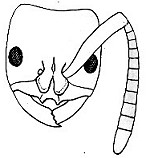 Clypeus with two large blunt teeth Clypeus with two large blunt teeth |
2 |
| -- |
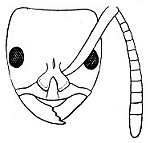 Clypeus without teeth Clypeus without teeth |
5 |
| 2 |
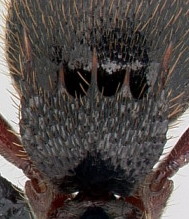 TL 9.5-9.8; in full face view some or all the vertex
behind the eyes with relatively coarse, arched and transverse
striations (derived from Bolton & Fisher, 2008b) TL 9.5-9.8; in full face view some or all the vertex
behind the eyes with relatively coarse, arched and transverse
striations (derived from Bolton & Fisher, 2008b) |
' |
| . |
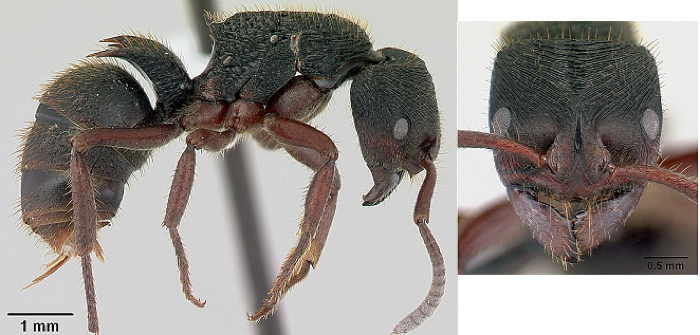 |
Congo
Basin & Liberia - transversa |
| -- |
Head with quite fine striations none of
which are transverse |
3 |
| 3 |
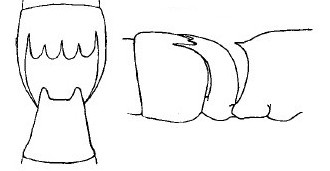 With
striated mandibles; the striations on the head are very divergent; the
alitrunk is shorter & more robust; the gaster is matt; densely
reticulo-punctate with large deep punctures but without true hair-pits
(fossettes) With
striated mandibles; the striations on the head are very divergent; the
alitrunk is shorter & more robust; the gaster is matt; densely
reticulo-punctate with large deep punctures but without true hair-pits
(fossettes) |
|
| . |
 |
Cameroun
& Zaïre - striatidens |
| -- |
Mandibles smooth; head with quite fine
striations |
4 |
| 4 |
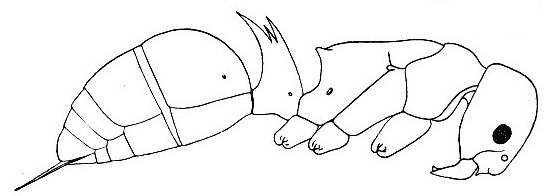 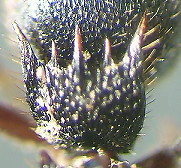 TL 6.5-7.5 mm, mandibles 4-toothed; petiole with short
spines but outer pair longer than median, and the latter not much
longer than intermediate spines - with several varieties TL 6.5-7.5 mm, mandibles 4-toothed; petiole with short
spines but outer pair longer than median, and the latter not much
longer than intermediate spines - with several varieties |
. |
| . |
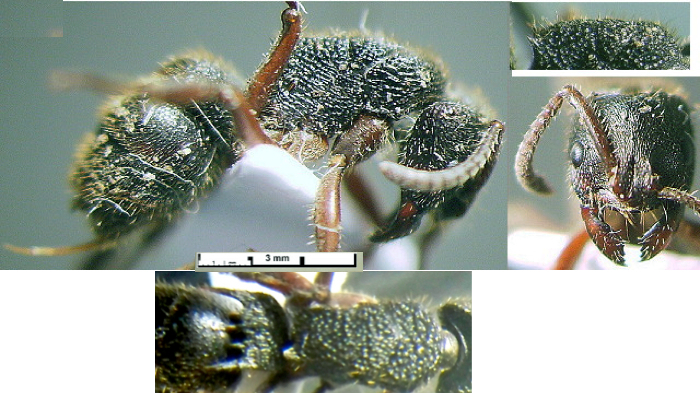 includes P.
heterodera includes P.
heterodera |
West
Africa & Congo Basin - gabonensis |
| . |
Clypeus with smooth, weakly arcuate anterior margin |
. |
| 5 |
 Small species, TL ca 6 mm, funicular joints 2-10 much
broader than long, petiole with external and median spines relatively
short and of equal lengths; black, mandibles and appendages dark brown
(queen only formally described) Small species, TL ca 6 mm, funicular joints 2-10 much
broader than long, petiole with external and median spines relatively
short and of equal lengths; black, mandibles and appendages dark brown
(queen only formally described) |
. |
| . |
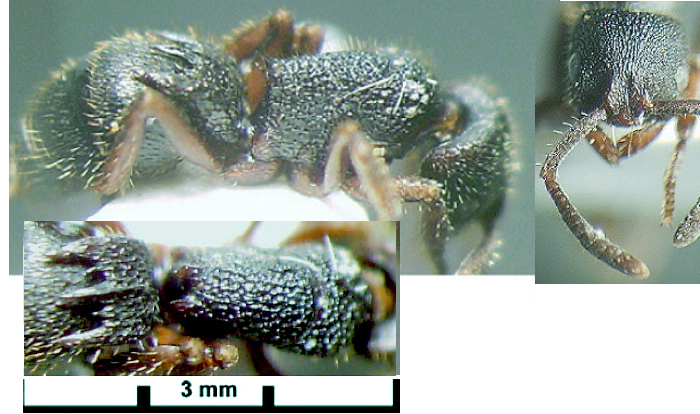 |
Congo
Basin & Ghana - bequaerti |
| -- |
Large species, TL 8-9.5 mm; mandibles and
appendages reddish-brown |
6 |
| 6 |
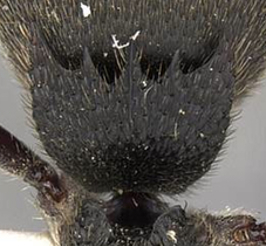 TL 11.5-12.0;
petiole with all spines short and about the
same length; gaster finely sculptured with a dense pelt of appressed
pubescence (derived from Bolton & Fisher, 2008b) TL 11.5-12.0;
petiole with all spines short and about the
same length; gaster finely sculptured with a dense pelt of appressed
pubescence (derived from Bolton & Fisher, 2008b) |
. |
| . |
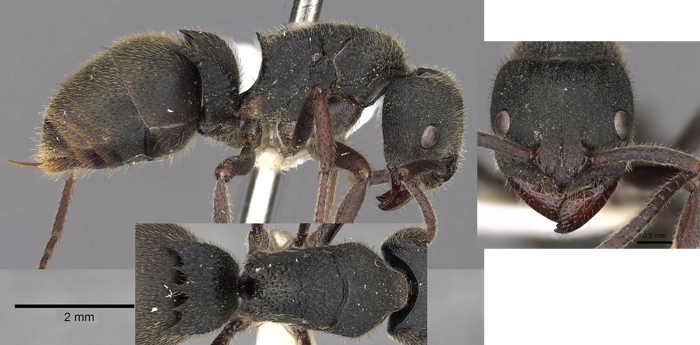 |
Tanzania
& Kenya - pulchella |
| -- |
 TL 9.0-10.5 mm; petiole with a median spine which is much
shorter than the outer spines but longer than the intermediate spines;
funicular joints 2-10 at least as long as broad; 6-10 slightly longer
than broad; scapes surpass occiput by about one-fifth of own length TL 9.0-10.5 mm; petiole with a median spine which is much
shorter than the outer spines but longer than the intermediate spines;
funicular joints 2-10 at least as long as broad; 6-10 slightly longer
than broad; scapes surpass occiput by about one-fifth of own length |
. |
| . |
 |
Cameroun & Congo
Basin - sveni |
|